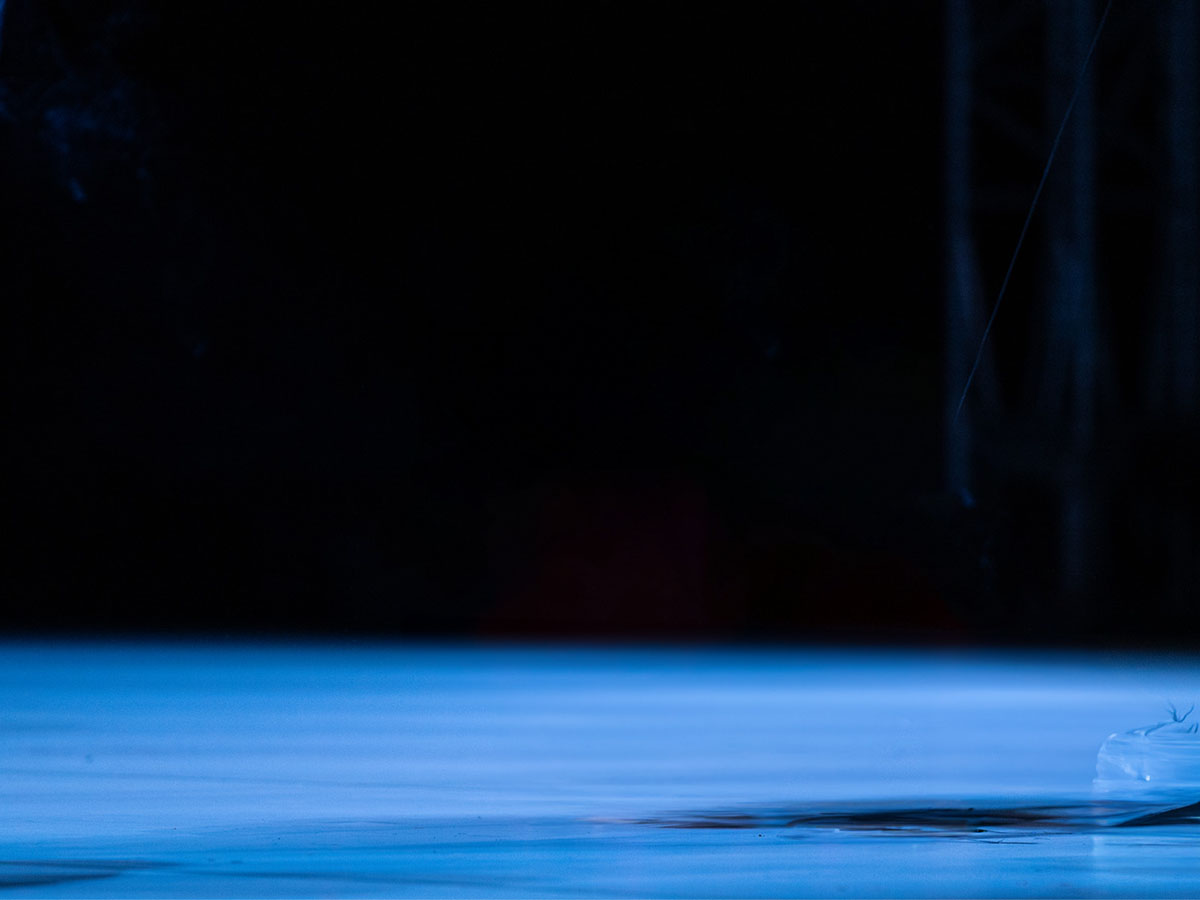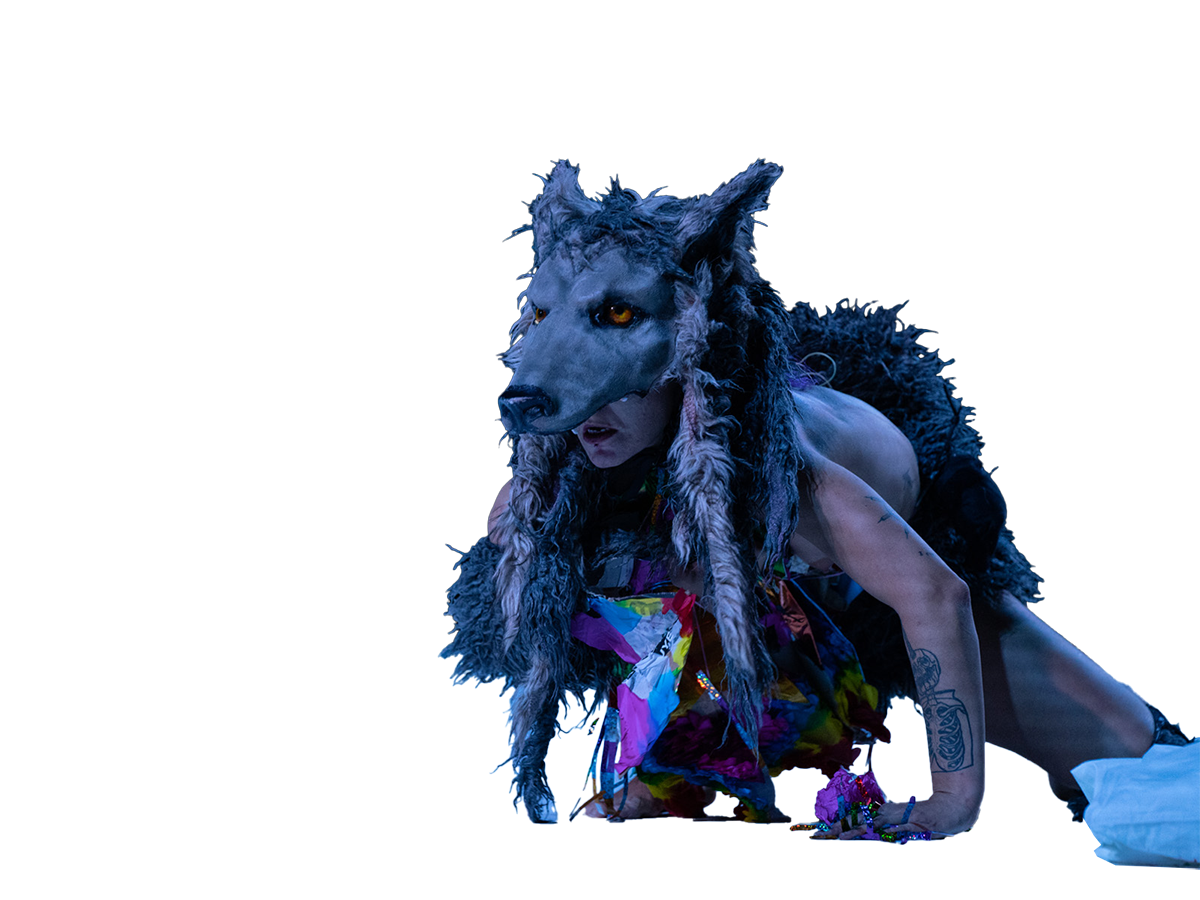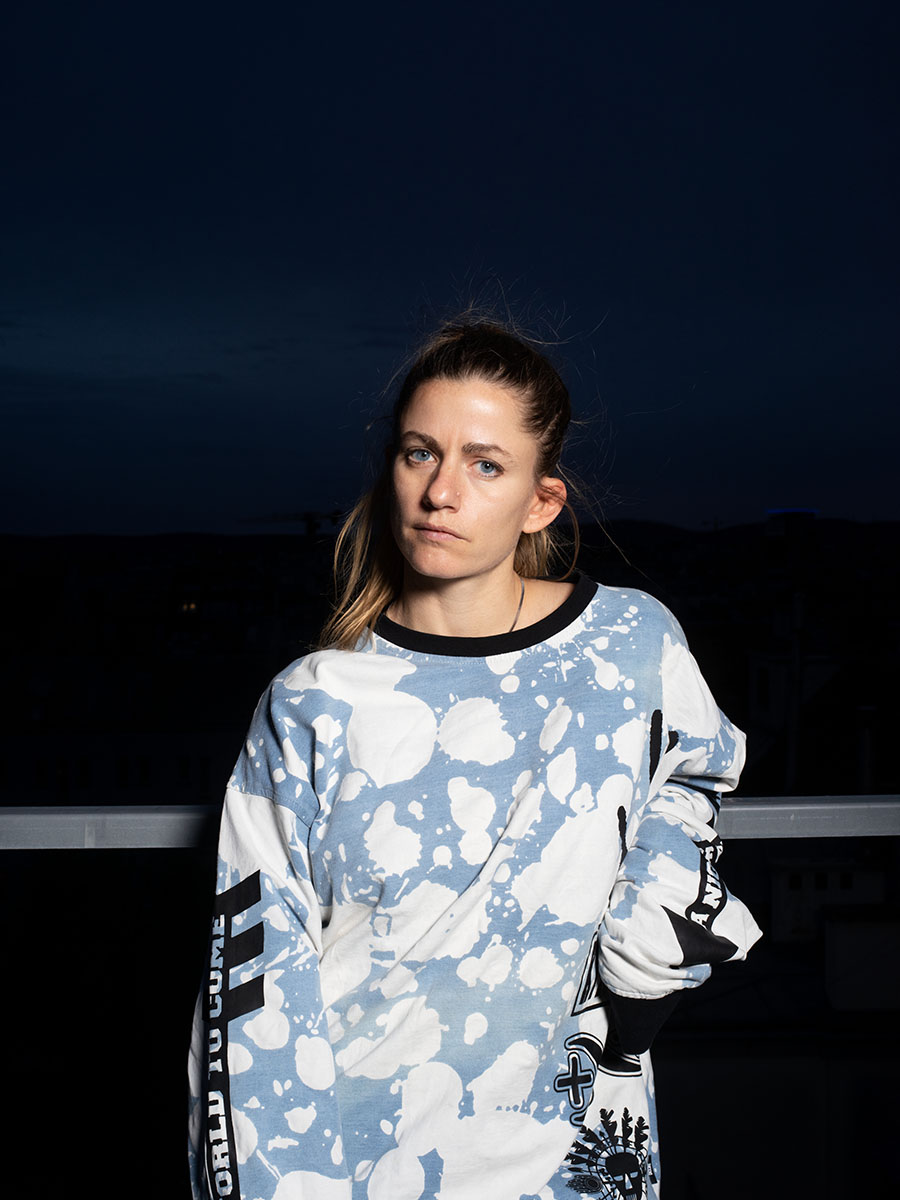



*with post-performance meet-the artist session
Includes English and German dialogues with partial Chinese and English surtitles
Approximately 140 minutes without intermission.
Text: Anna Leon
“Come on girls, bring the barres in.” Beatrice Cordua*, after a long career in ballet, stands on the stage of Florentina Holzinger’s TANZ and leads a ballet class. The students, only women, do pliés and jetés following her instructions. TANZ is the third work completing a trilogy – also including the works Recovery and Apollon – in which Holzinger looks back to the history of European ballet: after George Balanchine’s Agon and Apollon Musagète, here the starting point was Romantic ballet and the figure of the sylph, even if the work also turns towards later repertory, like Swan Lake.
Cordua’s staged ballet class looks nothing like what one would expect of it: the teacher is naked; the dancers gradually undress themselves as well; the class morphs into an orgasmic description of the students’ vaginas and to an invitation to “do the rats” – a wink to the name given to young corps de ballet dancers of the Paris Opera during the Romantic period. But the more TANZ diverges from the aesthetics of ballet, appropriating and desacralising it, the more Holzinger’s work approaches the very raw reality that this historical dance form still carries.
Romantic ballet was feminised: in stories centred around female protagonists, in its cult of female star dancers and in its overwhelmingly female corps de ballet, it celebrated and adulated a dancing womanhood. But this womanhood was to a great extent constructed through a male gaze upon it – from the dance critics engaging in detailed, almost voyeuristic descriptions of female dancers’ bodies to the well-off Paris Opera patrons who could have access backstage, to the thinly disguised sexual market of the foyer de la danse and from there to librettists writing ballet scripts in which women were victims in unhappy endings.
In TANZ, the all-female cast has learnt this lesson. The women on stage are followed, closely looked at and turned into images available to the audience through the projection of their acts and bodies filmed in real time. But the person operating the camera is also a woman, and her lens doesn’t only function for the satisfaction of voyeurism but also transmits the effort and concentration of the dancers, the work and exertion of their muscles. When the ballet class is over, and the performers engage in other activities of what Holzinger calls “Sylphic Studies”, any victimhood is effaced as the dancers defy gravity, pain, fear and mental and physical barriers.
Romantic ballet was attracted to the mysterious Other: in several works of the Romantic repertory, a juxtaposition is created between humanly inhabited, relatable settings and supernatural realms found in nature. It is in the magical settings in nature that many of Romantic ballet’s feminine figures dwell. These may be enchanting and/or enchanted creatures like wilis and sylphs, impersonated through a dance of elevation, with pointe work contributing to the sense of weightlessness and suspension emanating from the dancers; complex scenographic tricks like trap doors and pulley systems assisted in the illusion, with dancers risking accidents to fly across the stage. Romantic ballet’s feminine, supernatural figures were also, at times – like La Sylphide’s Madge – evil anti-heroines like witches, staged by employing the imagery of the – persecuted and tortured – “witch” in European history.
TANZ, at a time when the figure of the witch is reappropriated by feminism and ecofeminist approaches align struggles for women’s rights with the protection of nature, has once again learnt this lesson well – all too well. Midway through the piece, the stage background turns into a forest image. The performers impersonate and give birth to animals or transform into ghosts, highlighting their not-fully-human nature; a contemporary witch crosses the stage on her – electric – broom. But most crucially, the dancers strive against gravity and towards flying: on pointe, or using ropes and counterweights, or climbing on suspended motorbikes. The Sylph had wings attached to her costume at the level of her shoulder blades; Odette rippled her arms, engaging from the shoulder-blades outward, to impersonate a swan; both were ethereal and beautiful, concealing the effort required in order to have wings and fly. Towards the end of TANZ, a performer’s shoulder blades are literally attached to mechanical wings; the effort, pain, determination and power needed for this are made evident: here, ballet is not an illusion; it is very much real.
*In the Hong Kong performances, this cast is replaced by Claire Philippart.
Originally published at https://tqw.at/en/making-ballet-feminist-again-anna-leon/ (05.10.2019)
About Anna Leon
Anna Leon is a dance historian and theorist. She studied Psychology and Philosophy at the University of Bristol (United Kingdom) and the Philosophy of Art at Université Paris I Panthéon-Sorbonne (France). She completed a PhD in Dance Studies at the University of Salzburg with a thesis titled “Multiple Stories. Expanded Choreography and Choreographic History”.
In parallel with her research, Leon teaches practice-oriented dance history and theory in various contexts and occasionally works as a dramaturg.
As the theorist and researcher of TANZ, Leon wrote this introduction to Florentina Holzinger’s piece TANZ to provide audience members a glimpse into the history of Romantic ballet and to prepare them for the subversions elements introduced by the work’s contemporary sylphs.
Text: Catherine Yau
"I'm so obsessed with ballet because it's something that I have always felt excluded by," Florentina Holzinger, aged 38, one of the most sought-after Austrian choreographers in today’s international dance scene, recalled her relations with ballet. This rejection determined her mind to "make a ballet". Works of the ballet masters, like Vaslav Nijinsky and George Balanchine, therefore, became her subjects of research, investigation and conservation. Turning Balanchine’s Agon and Apollo into Recovery (2015) and Apollon (2017), Florentina scrutinised the athlete and extreme bodies exhibited in the works and paralleled those with elements of mutilation, martial arts, body building, bullfighting and more to form her own.
In TANZ (premiered in 2019), she turned her focus into Romantic ballet, in which the elements of “body” and “flight” interested her immensely. Romantic ballet, succeeding classical ballet in the early 19th century, rejected the classical order and gave way to free individual expression and imagination.
“Romantic ballet is very much busy with (flight) through the pointe shoes; the extension of the body makes the body defy gravity and appear as if floating and very weightless and creates very much the illusion of the boarding flight,” Florentina explained. The invention of the pointe shoes device, over which performers bleed and sweat over prolonged periods of training, fascinated her.
“Stunt ballet”, another development of the period, also grabbed her interest. Florentina illustrated that the development “went hand in hand with the development of stage machinery, from actual fire to gas lighting and so on,” which enabled the shows to create fantasy and illusion on stage. “So the ballerinas were hanging on ropes, and of course this would lead to a lot of accidents,” from which she found parallels in the stunt industry for television and cinemas nowadays. These are also some common elements that have always interested her and have been incorporated into her own works.
Narratives of the Romantic ballet stories were also another thing that had drawn her attention: “I thought the narratives from these early Romantic ballet works were interesting and funny and obscure and grotesque, and of course, a lot of Disneyesque narratives come from there. So, there is always the witch, the princess and the prince.” The haunting of the ephemeral beings, the fairies, spirits of nature and undead beings all gave inspirations to her own creation.
Re: TIME and SPACE
Among all the Romantic ballet repertoires, Florentina landed on La Sylphide (first premiered in 1832) as her blueprint for TANZ, transposing this almost 200-year-old ballet into new lights. The story of La Sylphide was not important, but the structure and elements were.
Resembling the structure with two acts in La Sylphide (the first act set in a realistic farmhouse, and the second act in a forest where fantasies happen), TANZ sets the first act as an “urban scenario of a ballet class” that most of the audience can relate and the second act where “surreal things happen and we kind of really, in a very sincere way, try to fly.” Florentina explained how she borrowed the historical structure for her own creation. She added a “divertissement” (an interim entertainment session that was also popular in historical ballets) between the two acts, partly to explain the research of the ballet piece and partly to get the audience ready for the intense second act.
“Flight” is the major element Florentina found interesting in La Sylphide. “I really want to be busy with this topic of suspension,” she spoke in amusement. She therefore developed what she called the “sylphidic studies”, investigating how a person could be suspended in the air with different devices, including the obvious pointe shoes, wire systems and the not-so-obvious hanging motorcycles, as well as the hair and even one’s own skin, exploring every corner of the aerial space. The radical hanging not only elevates the physical bodies of the performers but may also probably set the audience’s psychological space to flight.
In the performance, another expanded space is stretched through the “eyes” of the camera, zooming into the most secretive, intimate parts of the bodies, allowing this male gaze (or now all-gendered gaze) to turn into a new dimension. It also transports the audience back in time when ballet is often associated with eroticism and sex business.
At the same time, Florentina intruded even deeper, going beyond the surface, and choreographed with the internal ecology of the corporality. “I like to choreograph form as an artist, but I also like to choreograph everything that is inside of the body. For me it's clear the dancing body is not just the form that it makes, but it's also everything that is inside of it that we don't see. It is always clear for me to include this into the choreography.” So, blood and body fluids are choreographed subjects of the artist.
In TANZ, Florentina brings you from the past to the present, from the ground up to the space, and from outside to inside of a body.
“It was important for me to have different bodies.”
“When I grew up as a young girl, a ballerina was the image of beauty and what a woman ideally would look like and, of course, very much removed from any reality,” Florentina explained. She therefore set her aim to investigate thoroughly those notions of femininity and the representation of the female body on stage.
Exclusivity of certain body images on stage also bothered her; speaking from her personal experience with ballet, “it is very important to talk also about the exclusivity of certain body images on stage, especially since ballet is very much known for typecasting – one specific type of body … like body types, racial aspects, even class aspects to a certain degree.” Florentina tried to challenge conventions around this.
“It was important for me to have different bodies (on stage).” Inclusivity of different bodies is therefore very important in TANZ. “Everybody has a right to be on the stage,” Florentina emphasised. Her current cast, ranging in age from 29 to 62, speaks to her promise. In fact, when TANZ premiered, she engaged Beatrice Cordua (the first ballerina to dance naked in John Neumiere’s The Rite of Spring) in her eighties as the ballet teacher.
“I wouldn't have made TANZ if I hadn’t met a particular ballerina now in her eighties,” Florentina explained, noting that Cordua was the inspiration of the work. “I really really like to work with elderly people, because they bring a very long experience of living and also of a certain lived experience or profession with them … [Cordua] can [help us negotiate] around this topic of ballet” so that they are not “bashing” the ballet, which she thinks is multifaceted and complex, but to conduct a very in-depth analysis and share the experience around the ballet world.
Apart from the elderly body, Florentina also includes bodies from classical ballet, the circus and those from the sideshow (or the freak show), which were popularised from the mid-19th century to late 20th century and existed in the small tent next to the circus, where one could experience the obscure, seemingly dangerous and disturbing performances.
When Florentina mentioned to people about her ideas of suspension, “a lot of people from the body modification and piercing scene came to me and were like, ‘Well, we are doing this all the time.’” When she saw their practices of hanging from their own skin, she was astounded to realise how close a body could get on to “flight”, which she also wanted to exhibit for the audience.
When questioned about the mental and physical challenges Florentina has put onto the performers, she replied that she cast people already with specific or special skills and therefore was not really pushing their mental or physical boundaries. “In the moment of the performance, something looks very intense or very difficult. But it's not … It may look like it's dangerous or risky. But we are really just playing with that illusion of it.”
“I like to make it … a little bit painful for them.”
TANZ, recipient of the “Best Performance of the Year” by Theater Heute and the Nestroy Theatre Prize for Best Direction, is highly acclaimed in the arts world and welcomed by the international arts circles. Premiered five years ago, it has been performed over 65 times.
Florentina’s idea of theatre as experimental grounds for provocation and innovation certainly attracts her fans: “I like to make people think a lot, not make it too easy for them and challenge them, and maybe also become a little bit painful for them … But at the same time, it's very important for me that they are also very entertained and have a lot of fun, and for sure when they come out of the show, they are being like, ‘Wow, I never saw something like this before’ or ‘I never felt something like this before.’”
This “wow” effect not only drew audiences from the artistic cities in Europe but also in the relatively "patriarchal" and "misogynistic" cities like Kraków, Poland, and Kyoto, Japan, where women who are still in a lot of struggle could find liberation.
So, have you seen anything like this before? Do you feel the pain?

Photo: Elsa Okazaki
Concept, Performance and Choreography
Florentina Holzinger studied Choreography at the School for New Dance Development, Amsterdam University of the Arts. Her diploma solo work, Silk (2012), was awarded the Prix Jardin d’Europe at ImPulsTanz – Vienna International Dance Festival. Her second solo work, Recovery (2015), an experimental exploration of a traumatic stage accident she suffered, critically examines representations of women and the potential of female corporeality. Dissecting the narratives of ballet, Holzinger created Apollon (2017) and TANZ (2019), awarded Best Performance of the Year by Theater Heute and the Nestroy Theatre Prize for Best Direction. In 2020, she premiered the stunt-opera Etude for an Emergency at the Münchner Kammerspielen. In 2021, she created the large-scale performance A Divine Comedy for the Ruhrtriennale. Her next work, Ophelia's Got Talent (2022), received the Nestroy Theatre Prize for Best Actress (Saioa Alvarez Ruiz) and Best Stage Design (Nikolas Knezevic), as well as the FAUST Award for Best Dance Performance. In 2024, Holzinger premiered her first opera, SANCTA.


This performance is supported by the Federal Ministry Republic of Austria – Art, Culture, Civil Service and Sport.
Produced by: SPIRIT
For more programmes, please visit:
Overview page